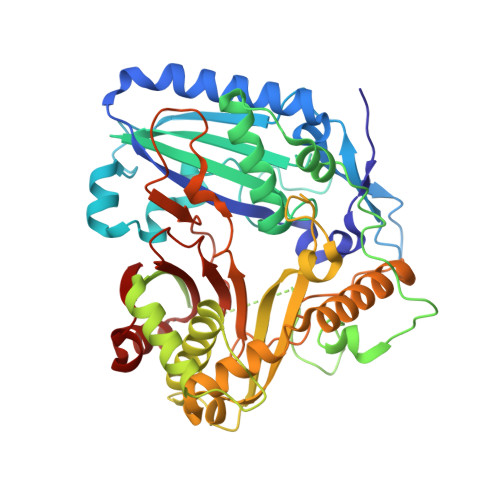Structural and Functional Characterization of the TRI101 Trichothecene 3-O-Acetyltransferase from Fusarium sporotrichioides and Fusarium graminearum: KINETIC INSIGHTS TO COMBATING FUSARIUM HEAD BLIGHT
Garvey, G.S., McCormick, S.P., Rayment, I.(2008) J Biological Chem 283: 1660-1669
- PubMed: 17923480
- DOI: https://doi.org/10.1074/jbc.M705752200
- Primary Citation of Related Structures:
2RKT, 2RKV, 2ZBA, 3B2S, 3B30 - PubMed Abstract:
Fusarium head blight (FHB) is a plant disease with serious economic and health impacts. It is caused by fungal species belonging to the genus Fusarium and the mycotoxins they produce. Although it has proved difficult to combat this disease, one strategy that has been examined is the introduction of an indigenous fungal protective gene into cereals such as wheat barley and rice. Thus far the gene of choice has been tri101 whose gene product catalyzes the transfer of an acetyl group from acetyl coenzyme A to the C3 hydroxyl moiety of several trichothecene mycotoxins. In vitro this has been shown to reduce the toxicity of the toxins by approximately 100-fold but has demonstrated limited resistance to FHB in transgenic cereal. To understand the molecular basis for the differences between in vitro and in vivo resistance the three-dimensional structures and kinetic properties of two TRI101 orthologs isolated from Fusarium sporotrichioides and Fusarium graminearum have been determined. The kinetic results reveal important differences in activity of these enzymes toward B-type trichothecenes such as deoxynivalenol. These differences in activity can be explained in part by the three-dimensional structures for the ternary complexes for both of these enzymes with coenzyme A and trichothecene mycotoxins. The structural and kinetic results together emphasize that the choice of an enzymatic resistance gene in transgenic crop protection strategies must take into account the kinetic profile of the selected protein.
- Department of Biochemistry, University of Wisconsin, Madison, Wisconsin 53706.
Organizational Affiliation:


















